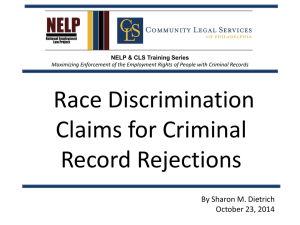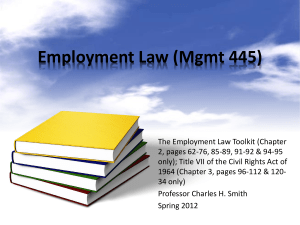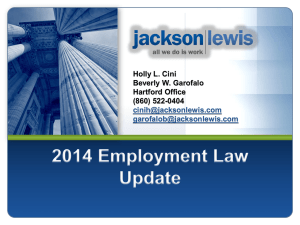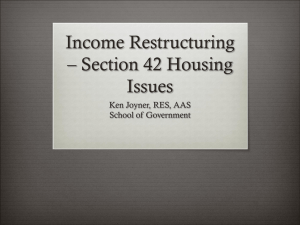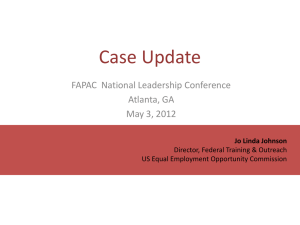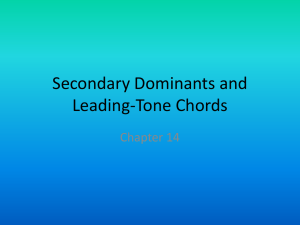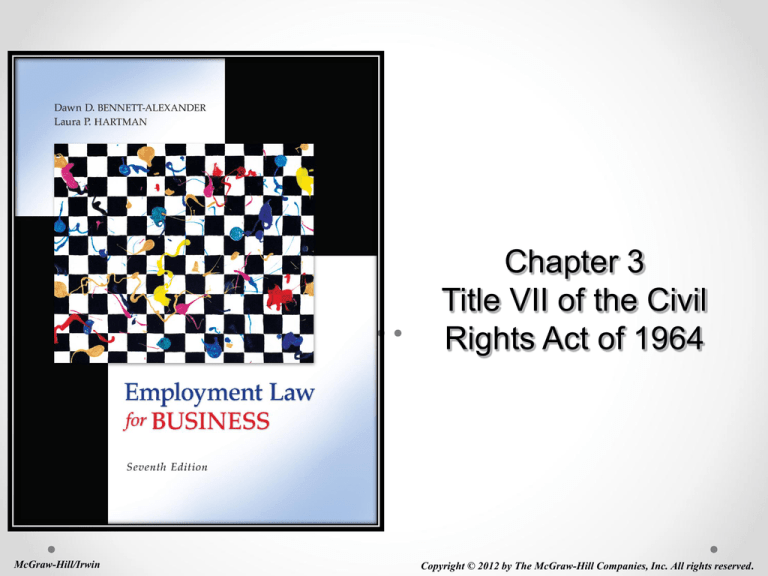
Chapter 3
Title VII of the Civil
Rights Act of 1964
McGraw-Hill/Irwin
Copyright © 2012 by The McGraw-Hill Companies, Inc. All rights reserved.
Learning Objectives
Explain the history leading up to passage of the
Civil Rights Act of 1964
Give examples of the ways that certain groups of
people were treated differently before passage
of the Civil Rights Act
Discuss what is prohibited by Title VII
Recognize who is covered by Title VII and who
is not
3-2
Learning Objectives
State how a Title VII claim is filed and proceeds
through the administrative process
Determine if a Title VII claimant is able to
proceed after receiving a no–reasonable-cause
finding
Distinguish between the various types of
alternative dispute resolution used by EEOC
3-3
Learning Objectives
Explain the Post-Civil War Statutes, including
what each is and what it does
Discuss what management can do to comply
with Title VII
3-4
A Historic Rights Act
Civil Rights Act of 1964
Prohibits discrimination in housing, education,
employment, public accommodations, and the receipt
of federal funds on the basis of race, color, gender,
national origin, or religion
3-5
Title VII of the
Civil Rights Act of 1964
Title VII of the Civil Rights Act of 1964 is the
employment section of the act
State and local governments passed laws paralleling
Title VII and the other protective legislation
Affects on employers
Prohibitions
Regulations
3-6
Title VII of the
Civil Rights Act of 1964
Amendments to the Act
Equal Employment Opportunity Act
Pregnancy Discrimination Act
Civil Rights Act of 1991
Congressional Accountability Act of 1995
EEOC
Job discrimination
Employment discrimination
3-7
Title VII Provisions
An employer cannot discriminate on the basis of
Race
Color
Gender
Religion
National origin
3-8
Title VII Provisions
In making decisions regarding
Hiring/firing
Training
Discipline
Compensation
Benefits
Classification
Or other terms or conditions of employment
3-9
Who Must Comply with Title VII?
Employers
Unions
Joint labor and management committees making
admission, referral, training, and other decisions
3-10
Who Must Comply with Title VII?
Employment agencies and other similar hiring
entities making referrals for employment
All private employers employing 15 or more
employees
Federal, state, and local governments
3-11
Who is Covered by Title VII
Public (governmental) employees
Private (non-governmental) employees
Undocumented workers
Undocumented workers may not be eligible for certain
forms of relief, such as reinstatement and back pay
3-12
Employees Who Are Not Covered by
Title VII
Employees of employers having less than 15
employees
Employees whose employers are not engaged
in interstate commerce
Non-U.S. citizens employed outside the United
States
Employees of religious institutions, associations,
or corporations hired to perform work connected
with carrying on religious activities
3-13
Employees Who Are Not Covered by
Title VII
Members of Communist organizations
Employers employing Native Americans living in
or around Native American reservations
Employers who are engaged in interstate
commerce but do not employ 15 or more
employees for each of 20 or more calendar
weeks in the current or preceding calendar year
3-14
Filing Claims under Title VII
Claimant/ charging party: The person who
brings an action alleging violation of Title VII
Vast majority of charges are sifted out of the system
The EEOC has a success rate of 90 percent in
litigation
3-15
Filing Claims under Title VII
Statute of limitation
Non-federal government employees within 180
days of the discriminatory event
Federal employees within 45 days of the
discriminatory event
Record keeping and reporting requirements:
Requirement under Title VII that certain
documents must be maintained and periodically
reported to the EEOC
3-16
State Law Interface in the Filing
Process
706 agency: Work-sharing agreement with the
EEOC
Conciliation: Attempting to reach agreement on
a claim through discussion, without resort to
litigation
Expanded filing time
3-17
Proceeding Through the EEOC
Respondent/ responding party: Person
alleged to have violated Title VII, usually the
employer
Within 10 days of the claim, the EEOC serves
notice of the charge to the employer
Antiretaliation provisions
3-18
Mediation
Attempt to streamline the EEOC case handling
process
Alternative to a full-blown EEOC investigation
“Referral-back” program
Universal mediation agreements
60 to 70 percent of incoming cases are offered
mediation
Agreements reached are binding
3-19
EEOC Investigation
EEOC’s determination of reasonable cause
Reasonable cause: EEOC finding that Title VII was
violated
No-reasonable-cause finding
No reasonable cause: EEOC finding that evidence
indicates no reasonable basis to believe Title VII was
violated
Dismissal and notice of rights (right-to-sue letter)
3-20
EEOC Investigation
Reasonable-cause finding
Meeting with EEO investigator
EEO investigator: Employee of EEOC who reviews
Title VII complaints for merit
3-21
Judicial Review
Judicial review: Court review of an agency’s
decision
De novo review: Complete new look at
administrative case by the reviewing court
Mediation provides an alternative between
litigation and mandatory arbitration
3-22
Judicial Review
Mandatory arbitration agreements
Federal Arbitration Act
Jury trials
The Civil Rights Act of 1991
Awards compensatory and punitive damages
3-23
The Reconstruction Civil Rights Acts
42 U.S.C. Section 1981. – Equal Rights under
the Law
42 U.S.C. Section 1983. – Civil Action for
Deprivation of Rights
42 U.S.C. Section 1985. – Conspiracy to
Interfere with Civil Rights
The Ku Klux Klan Act
3-24
An Important Note
Discrimination claims under Title VII and other
employment discrimination legislation must be
proved just as any other lawsuit
The employee must offer evidence to support
any claims
3-25
An Important Note
Employers do not have to fear being sued if they
consistently treat employees in a protected class
just as they would those of any other similarly
situated employee
Title VII is not a job guarantee for women and
minorities
3-26
Management Tips
Make sure that all employees understand
What Title VII is
What Title VII requires
Who Title VII applies to
How the employees’ actions can bring about liability
for the employer
3-27
Management Tips
Ensure that employees know
What kinds of actions will be looked at in a Title VII
proceeding
That the employer will not allow Title VII to be violated
That all employees have a right to a workplace free of
illegal discrimination
3-28

